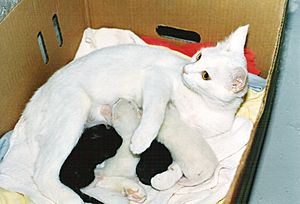Lactation facts for kids
Lactation is when a mother's body makes and releases milk to feed her young. This happens in almost all female mammals after their babies are born. For humans, this process is also called breastfeeding or nursing.
In most animals, milk comes out of the mother's nipples. But some animals are different! For example, the platypus is a special type of mammal called a monotreme. It releases milk through small holes on its belly. There's only one mammal where males normally make milk: the Dayak fruit bat.
How Milk is Made
Making milk needs special chemicals called hormones. The two main hormones are prolactin (PRL) and oxytocin. These hormones tell the body when and how much milk to produce.
Scientists believe that milk production developed from something older mammals already had. The cells that make milk came from special glands in the skin. This means that because early mammals had glands in their skin, they were able to develop the ability to make milk.
Why Mother's Milk is Important
Mother's milk is more than just food for babies. It also contains special protectors called antibodies. These antibodies help protect the baby from sickness. They work until the baby's own immune system is strong enough.
When a baby is born, it gets some antibodies (called IgG) from its mother through the placenta. But it takes about six months for a baby to make its own antibodies. So, mom's milk gives them other antibodies (like IgA) to help protect them until then.
Images for kids
-
A mother coyote making milk, with her teats visible
See also
 In Spanish: Lactancia para niños
In Spanish: Lactancia para niños





